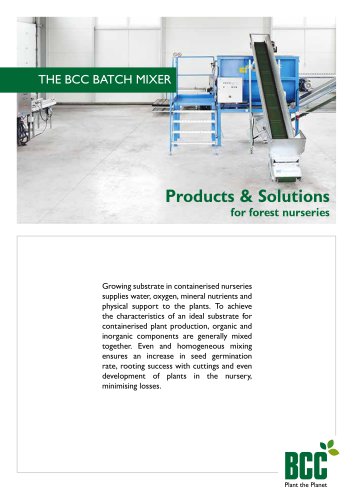
Catalog excerpts

he common pine weevil, Hylobius abietis, is causing the Swedish forestry sector major damage. Experts estimate damages cost up to nearly one billion Swedish Kronor annually! Over the past 150 years, scientists have developed various protection methods to reduce pine weevil attacks in our forests. Stump extraction, metal collars, prescribed rest and numerous insecticides are just some methods that have been tested. Since the 1940s and onwards, insecticides have almost exclusively been the most common protection method against the pine weevil. This type of protection has shown to have a...
Open the catalog to page 2
Conniflex can simply be described as an armor of sand applied to the stem of seedling” onniflex is the new, effective and environmentally friendly coating method, protecting the forest seedling against pine weevil attacks. Conniflex as a protection method was first initiated and developed by researchers at the Swedish University of Agricultural Sciences, SLU. Conniflex can simply be described as an armor of sand applied to the stem of seedling. The coating is flexible and expands as the seedling grows. The specially developed and water-based glue is used to guarantee that the sand bonds to...
Open the catalog to page 3
The seedlings are gently separated by a transversal comb and to allow nozzles to apply the environment-friendly glue” efore packing and delivery, seedlings will be treated with Conniflex. Growing trays are placed in an automatic frame handling system. The trays are pushed from the frame and onto the belt conveyor and guided into the gluing unit. It is important to first wet approximately two thirds of the stem using water jets. This is sufficient for effective application of the glue. Water jets are used for the water-based glue to bond firmly to the stem. The trays are then transported to...
Open the catalog to page 4
Sanding unit carefully fractioned, partly to counter attacks by pine weevil jaws and partly to avoid creating gaps in the protection. Surplus sand is collected in a hopper, then filtered and transported back into the system for re-use. Wet sand, needles and other particles are separated by sieving and guided to a collection vessel. Sand grains have been carefully fractioned, partly to counter attacks by pine weevil jaws and partly to avoid creating gaps in the protection” After coating, the tray is transported on the belt conveyor and towards the final drying unit. fter the glue has been...
Open the catalog to page 5
Drying unit fter the coating process the glue needs to be hardened before the protection is complete and the seedlings can be packed. This is done in a controlled environment in the drying unit to avoid drying out or damage to the seedling. The seedlings are transported slowly through the drying system’s three levels. The speed of the belt conveyors is individually adjustable for flexibility. The fan and heating system in each drying module ensures that the optimal temperature is maintained and that air is forced through the seedlings. The seedlings are tranpsorted between the floors by the...
Open the catalog to page 6All BCC AB catalogs and technical brochures
-
BCC Tray Destacker
4 Pages
-
The BCC Watering Tunnel
3 Pages
-
THE BCC BATCH MIXER
4 Pages
-
SideSlit Cell150
9 Pages
-
Tray Washer
4 Pages
-
Tray Covering Unit
4 Pages
-
Precision Seeder
3 Pages
-
Flexi Filler
4 Pages
-
Dibbler
4 Pages
-
Planting tube 38
9 Pages
-
Holding Area Boom
4 Pages
-
Greenhouse Boom
4 Pages
-
Nursery In a Box
7 Pages
-
Gravity Separator
4 Pages
-
Germination Table
4 Pages
-
Cleaner & Seed Sizer
3 Pages


















